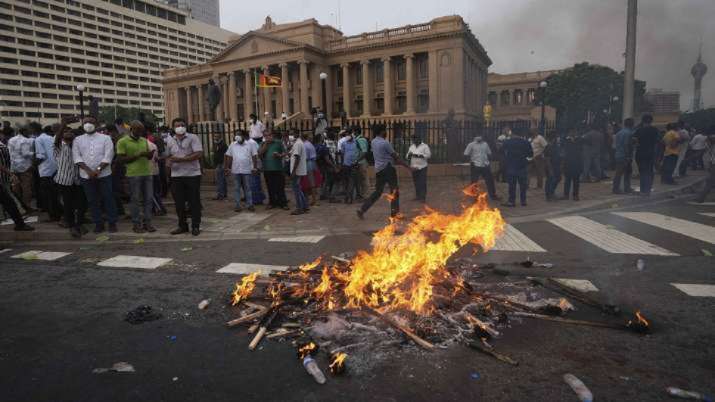
Supporters of Sri Lanka’s main opposition party burn placards during a protest outside the presidential office in Colombo, Sri Lanka.
Highlight
- Sri Lankan Prime Minister said the country’s economy ‘collapsed’
- There is generally no shortage of food in tropical Sri Lanka but people are starving
- Doctors have taken to social media to procure vital supplies of equipment and medicine
Sri Lanka’s prime minister says the island nation’s debt-laden economy “collapsed” because it had no money to pay for food and fuel. Short of cash to pay for imports of such needs and already defaulting on its debt, it is seeking help from neighboring India and China and from the International Monetary Fund.
Prime Minister Ranil Wickremesinghe, who took office in May, was emphasizing the crucial task he faced in transforming an economy he said is headed for “rock bottom”. Sri Lankans are giving up on food as they face shortages, queuing for hours to try to buy the scarce fuel. This is a harsh reality for a country whose economy was booming, with a growing and comfortable middle class, until the latest crisis deepened.
How serious is this crisis?
There is generally no shortage of food in tropical Sri Lanka but people are starving. The United Nations World Food Program says nine out of 10 households are skipping meals or otherwise skimping on their food intake, while 3 million are receiving emergency humanitarian aid.
Doctors have taken to social media to procure vital supplies of equipment and medicine. An increasing number of Sri Lankans are asking for a passport to go abroad in search of work. Government employees have been given an extra day off for three months to give them time to grow their own food. In short, people are suffering and desperate for things to improve.
Why is the economy in such a bad shape?
Economists say the crisis stems from years of domestic factors such as mismanagement and corruption, but also from other problems such as a USD 51 billion rise in debt, the impact of the pandemic and terror attacks on tourism, and other problems.
Much of the public outcry has focused on President Gotabaya Rajapaksa and his brother, former Prime Minister Mahinda Rajapaksa. He later resigned after weeks of anti-government protests that eventually turned violent.
The situation has been getting worse for the last several years. In 2019, Easter suicide bombings in churches and hotels killed more than 260 people. It devastated tourism, a major source of foreign exchange.
The government needed to boost its revenues as foreign debt for major infrastructure projects soared, but instead Rajapaksa pushed for the biggest tax cut in Sri Lanka’s history, which was recently reversed. Creditors downgraded Sri Lanka’s rating, barring it from borrowing more money as its foreign reserves sank. Then tourism fell flat again during the pandemic.
In April 2021, Rajapaksa abruptly banned the import of chemical fertilisers. The push for organic farming caught farmers by surprise and destroyed staple rice crops, driving up prices. Imports of other items considered to be luxuries were also banned in order to save foreign exchange. Meanwhile, the Ukraine war has driven up food and oil prices. Inflation in May was close to 40% and food prices increased by around 60%.
Why did the Prime Minister say that the economy has collapsed?
Such a drastic announcement can undermine any confidence in the state of the economy and does not reflect any particular new development. Wickremesinghe appears to be underscoring the challenge to his government of seeking help from the IMF and facing criticism over the lack of reform since he took office weeks ago. He is also brushing off criticism from within the country. His remarks may be aimed at trying to buy more time and support as he tries to get the economy back on track.
The finance ministry says Sri Lanka has only $25 million in usable foreign reserves. This has left it to pay for imports, let alone billions in debt.
Meanwhile the Sri Lankan Rupee has weakened by almost 80% in value from around 360 to USD 1. This makes the cost of imports even more prohibitive. Sri Lanka has suspended repayment of about USD 7 billion in foreign debt due this year out of USD 25 billion to be repaid by 2026.
What is the government doing about it?
Wickremesinghe has a lot of experience. This is his sixth term as the latest prime minister. As of now, Sri Lanka has been wrangling through, mainly backed by USD 4 billion in credit lines from neighboring India. An Indian delegation was in the capital Colombo on Thursday to negotiate more aid, but Wickremesinghe warned against expecting India to keep Sri Lanka afloat for a long time.
Thursday’s headline in the Colombo Times newspaper said, “Sri Lanka puts its last hopes on the IMF. Government is in talks with the IMF on a bailout plan. Wickremesinghe said on Wednesday that they have to have a preliminary agreement with the IMF by the end of July.” The government is also seeking more help from China. Other governments such as the US, Japan and Australia have provided a few hundred million dollars in additional aid.
Earlier this month, the United Nations launched a worldwide public appeal for aid. As of now, the estimated funding barely scratches the surface of the $6 billion that the country needs to keep afloat over the next six months.
To counter Sri Lanka’s fuel shortage, Wickremesinghe recently told The Associated Press in an interview that he would consider buying more subsidized oil from Russia to help the country tide over the crisis.
Read also: Sri Lankan PM said – economy ‘falls’, unable to buy oil
Read also: Sri Lanka’s fuel crisis hits new heights: Government to close offices, schools from next week